SCM Strategies and Transitional Planning to E-Business for Tawazon
VerifiedAdded on 2023/06/07
|28
|7320
|458
Report
AI Summary
This report explores the essentiality and implementation of various technologies for Tawazon Interior Design, a UAE-based organization, as it transitions from traditional business management to an e-business infrastructure. The focus is on Supply Chain Management (SCM) and logistics operations, emphasizing tools and technological interventions like RFID, cloud computing, and Service Oriented Architecture (SOA). The report details the company's background, market situation, and competition, highlighting the importance of business intelligence and SCM tools such as CRM, SRM, ERP, and WMS. It also discusses adopting updated technologies, database efficiency, and a transitional plan to e-business, including diagnosis, change management, and implementation strategies, ultimately providing recommendations for a simple and effective e-business infrastructure.
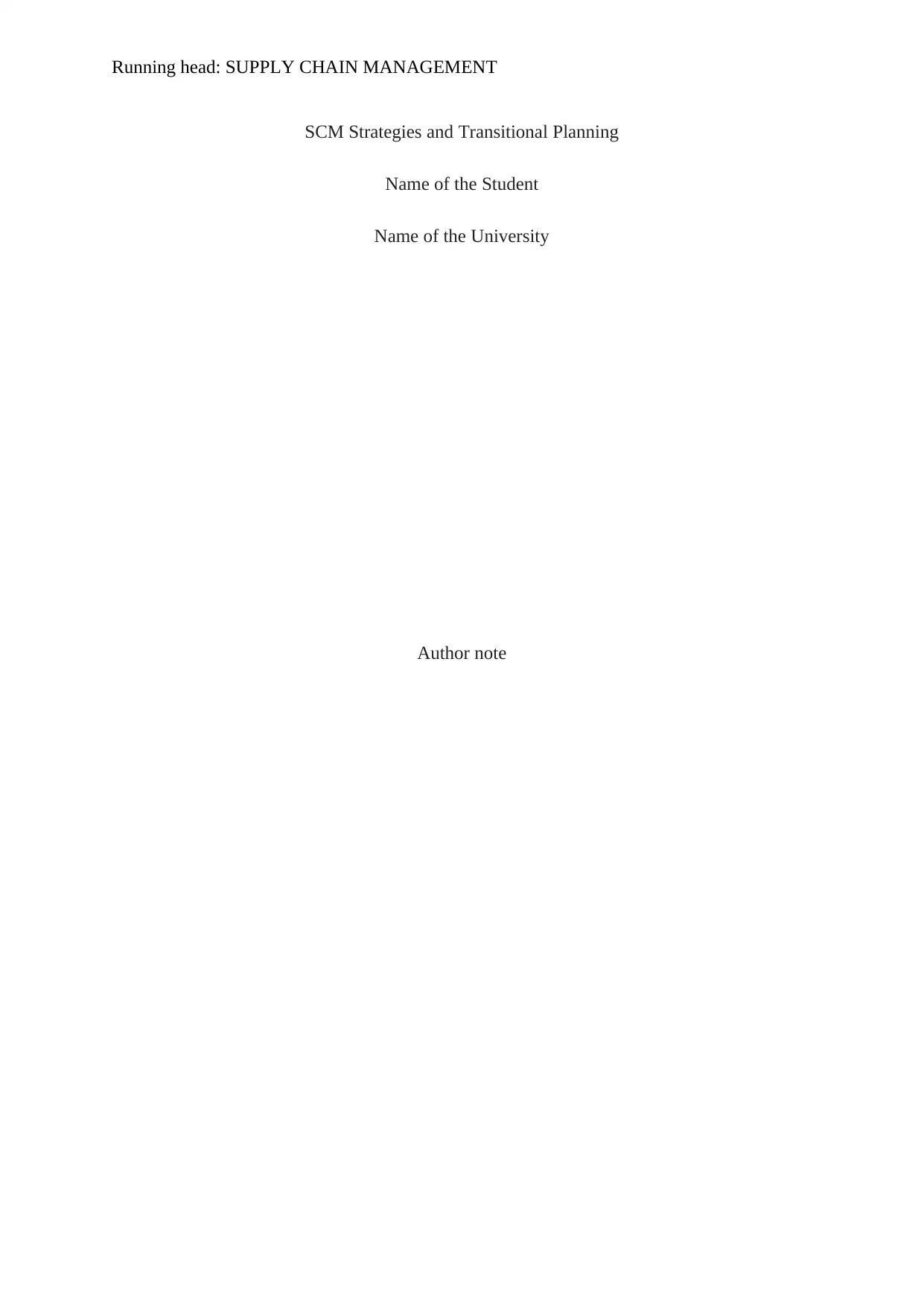
Running head: SUPPLY CHAIN MANAGEMENT
SCM Strategies and Transitional Planning
Name of the Student
Name of the University
Author note
SCM Strategies and Transitional Planning
Name of the Student
Name of the University
Author note
Paraphrase This Document
Need a fresh take? Get an instant paraphrase of this document with our AI Paraphraser
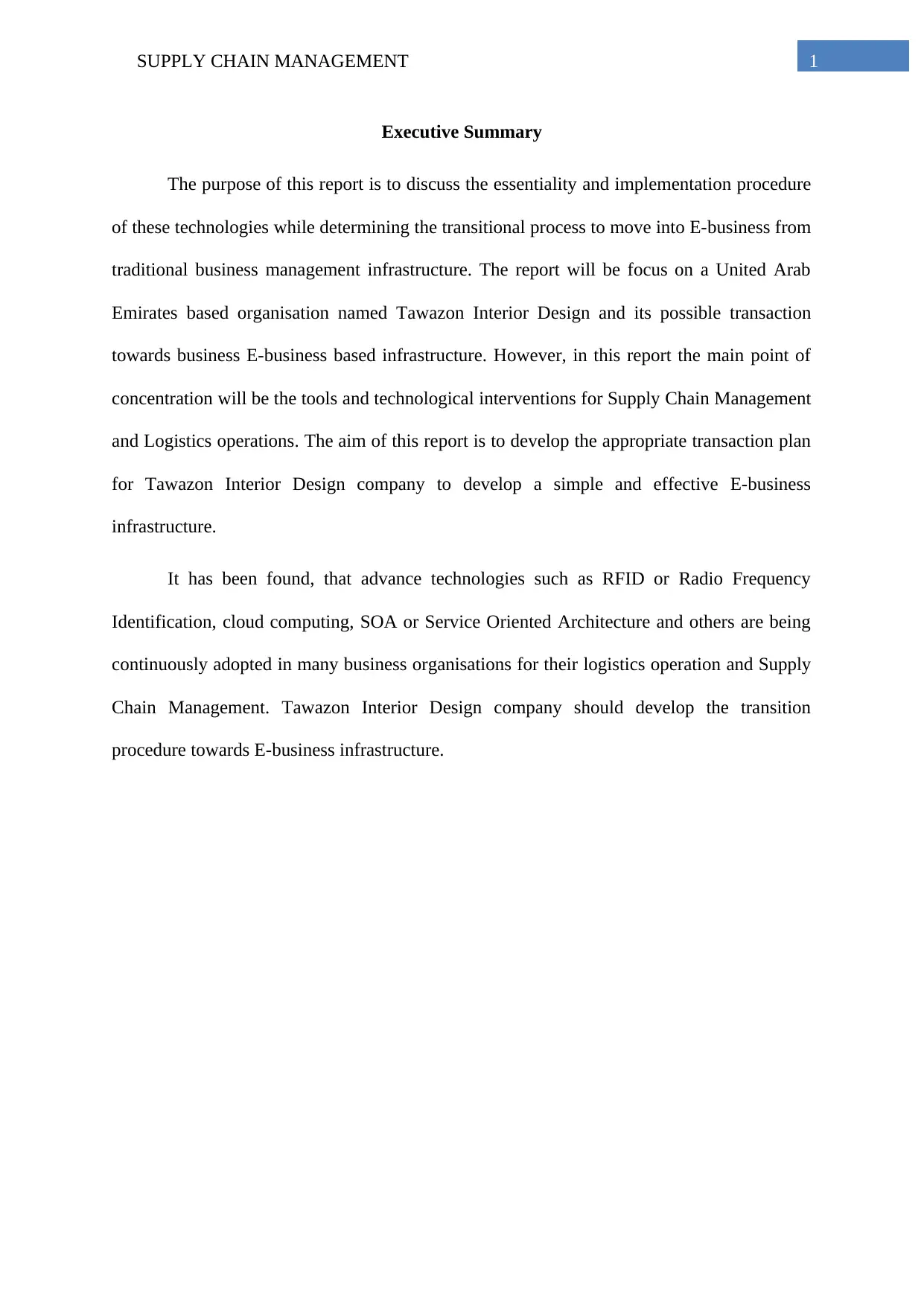
1SUPPLY CHAIN MANAGEMENT
Executive Summary
The purpose of this report is to discuss the essentiality and implementation procedure
of these technologies while determining the transitional process to move into E-business from
traditional business management infrastructure. The report will be focus on a United Arab
Emirates based organisation named Tawazon Interior Design and its possible transaction
towards business E-business based infrastructure. However, in this report the main point of
concentration will be the tools and technological interventions for Supply Chain Management
and Logistics operations. The aim of this report is to develop the appropriate transaction plan
for Tawazon Interior Design company to develop a simple and effective E-business
infrastructure.
It has been found, that advance technologies such as RFID or Radio Frequency
Identification, cloud computing, SOA or Service Oriented Architecture and others are being
continuously adopted in many business organisations for their logistics operation and Supply
Chain Management. Tawazon Interior Design company should develop the transition
procedure towards E-business infrastructure.
Executive Summary
The purpose of this report is to discuss the essentiality and implementation procedure
of these technologies while determining the transitional process to move into E-business from
traditional business management infrastructure. The report will be focus on a United Arab
Emirates based organisation named Tawazon Interior Design and its possible transaction
towards business E-business based infrastructure. However, in this report the main point of
concentration will be the tools and technological interventions for Supply Chain Management
and Logistics operations. The aim of this report is to develop the appropriate transaction plan
for Tawazon Interior Design company to develop a simple and effective E-business
infrastructure.
It has been found, that advance technologies such as RFID or Radio Frequency
Identification, cloud computing, SOA or Service Oriented Architecture and others are being
continuously adopted in many business organisations for their logistics operation and Supply
Chain Management. Tawazon Interior Design company should develop the transition
procedure towards E-business infrastructure.
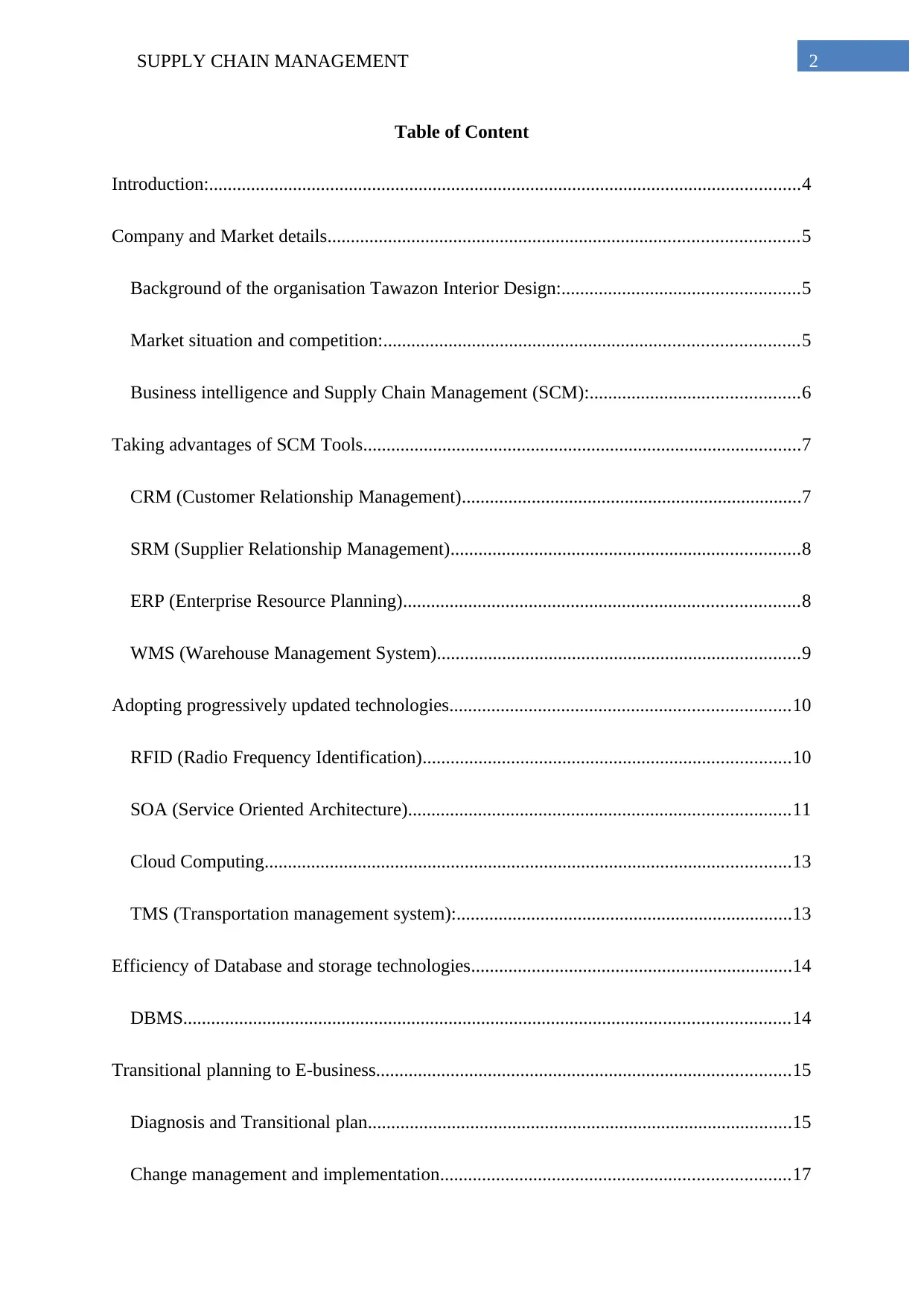
2SUPPLY CHAIN MANAGEMENT
Table of Content
Introduction:...............................................................................................................................4
Company and Market details.....................................................................................................5
Background of the organisation Tawazon Interior Design:...................................................5
Market situation and competition:.........................................................................................5
Business intelligence and Supply Chain Management (SCM):.............................................6
Taking advantages of SCM Tools..............................................................................................7
CRM (Customer Relationship Management).........................................................................7
SRM (Supplier Relationship Management)...........................................................................8
ERP (Enterprise Resource Planning).....................................................................................8
WMS (Warehouse Management System)..............................................................................9
Adopting progressively updated technologies.........................................................................10
RFID (Radio Frequency Identification)...............................................................................10
SOA (Service Oriented Architecture)..................................................................................11
Cloud Computing.................................................................................................................13
TMS (Transportation management system):........................................................................13
Efficiency of Database and storage technologies.....................................................................14
DBMS..................................................................................................................................14
Transitional planning to E-business.........................................................................................15
Diagnosis and Transitional plan...........................................................................................15
Change management and implementation...........................................................................17
Table of Content
Introduction:...............................................................................................................................4
Company and Market details.....................................................................................................5
Background of the organisation Tawazon Interior Design:...................................................5
Market situation and competition:.........................................................................................5
Business intelligence and Supply Chain Management (SCM):.............................................6
Taking advantages of SCM Tools..............................................................................................7
CRM (Customer Relationship Management).........................................................................7
SRM (Supplier Relationship Management)...........................................................................8
ERP (Enterprise Resource Planning).....................................................................................8
WMS (Warehouse Management System)..............................................................................9
Adopting progressively updated technologies.........................................................................10
RFID (Radio Frequency Identification)...............................................................................10
SOA (Service Oriented Architecture)..................................................................................11
Cloud Computing.................................................................................................................13
TMS (Transportation management system):........................................................................13
Efficiency of Database and storage technologies.....................................................................14
DBMS..................................................................................................................................14
Transitional planning to E-business.........................................................................................15
Diagnosis and Transitional plan...........................................................................................15
Change management and implementation...........................................................................17
⊘ This is a preview!⊘
Do you want full access?
Subscribe today to unlock all pages.

Trusted by 1+ million students worldwide
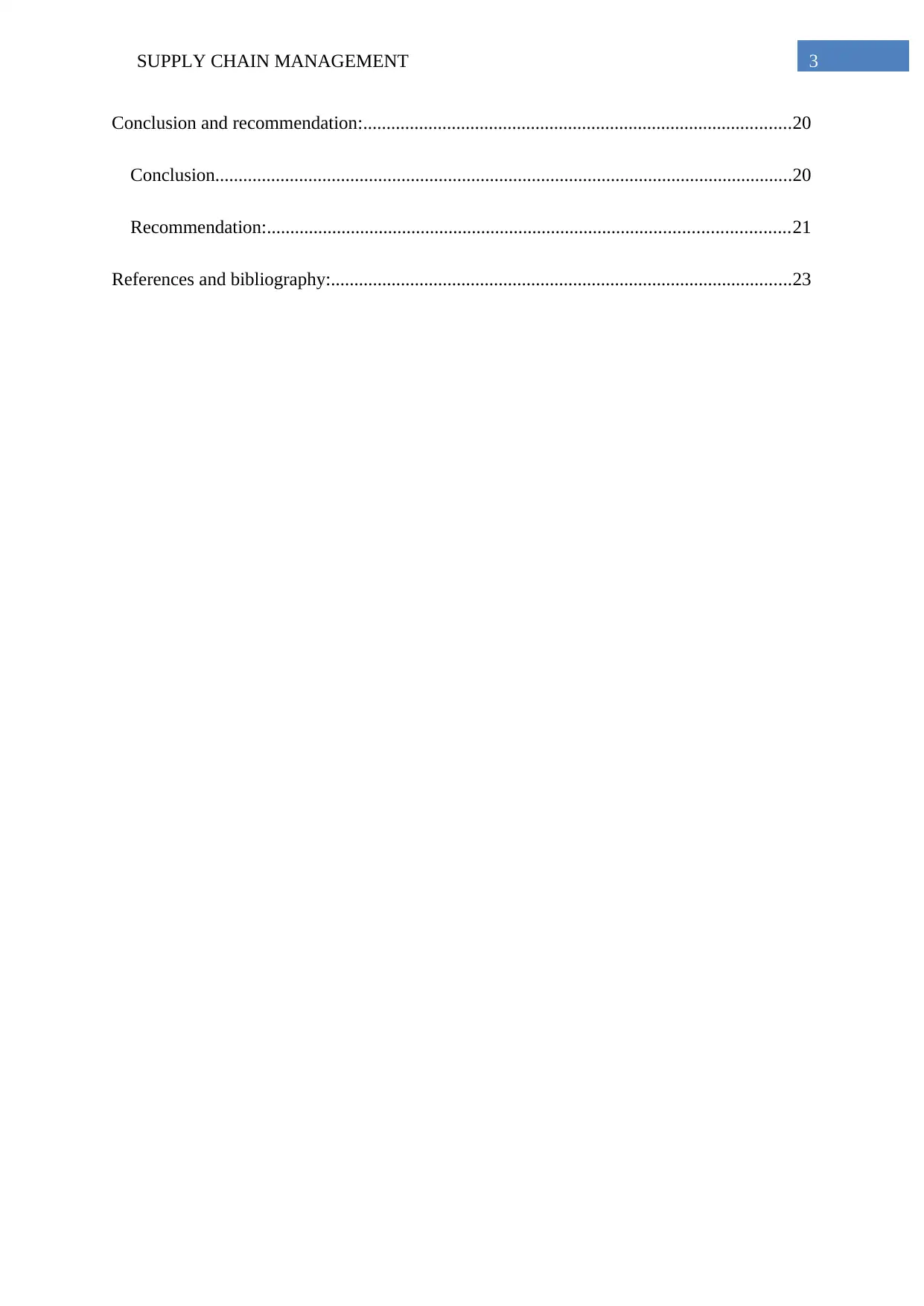
3SUPPLY CHAIN MANAGEMENT
Conclusion and recommendation:............................................................................................20
Conclusion............................................................................................................................20
Recommendation:................................................................................................................21
References and bibliography:...................................................................................................23
Conclusion and recommendation:............................................................................................20
Conclusion............................................................................................................................20
Recommendation:................................................................................................................21
References and bibliography:...................................................................................................23
Paraphrase This Document
Need a fresh take? Get an instant paraphrase of this document with our AI Paraphraser
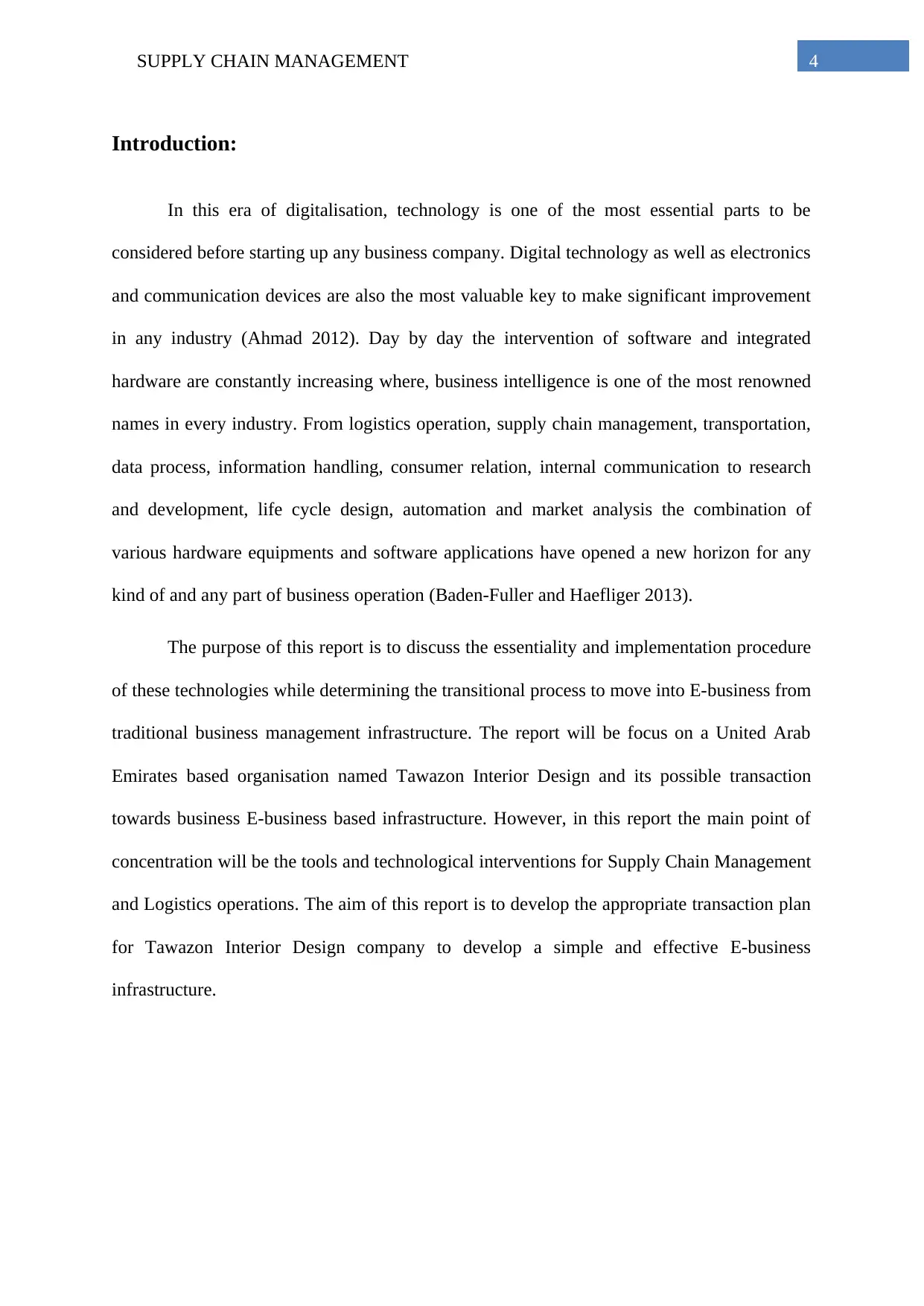
4SUPPLY CHAIN MANAGEMENT
Introduction:
In this era of digitalisation, technology is one of the most essential parts to be
considered before starting up any business company. Digital technology as well as electronics
and communication devices are also the most valuable key to make significant improvement
in any industry (Ahmad 2012). Day by day the intervention of software and integrated
hardware are constantly increasing where, business intelligence is one of the most renowned
names in every industry. From logistics operation, supply chain management, transportation,
data process, information handling, consumer relation, internal communication to research
and development, life cycle design, automation and market analysis the combination of
various hardware equipments and software applications have opened a new horizon for any
kind of and any part of business operation (Baden-Fuller and Haefliger 2013).
The purpose of this report is to discuss the essentiality and implementation procedure
of these technologies while determining the transitional process to move into E-business from
traditional business management infrastructure. The report will be focus on a United Arab
Emirates based organisation named Tawazon Interior Design and its possible transaction
towards business E-business based infrastructure. However, in this report the main point of
concentration will be the tools and technological interventions for Supply Chain Management
and Logistics operations. The aim of this report is to develop the appropriate transaction plan
for Tawazon Interior Design company to develop a simple and effective E-business
infrastructure.
Introduction:
In this era of digitalisation, technology is one of the most essential parts to be
considered before starting up any business company. Digital technology as well as electronics
and communication devices are also the most valuable key to make significant improvement
in any industry (Ahmad 2012). Day by day the intervention of software and integrated
hardware are constantly increasing where, business intelligence is one of the most renowned
names in every industry. From logistics operation, supply chain management, transportation,
data process, information handling, consumer relation, internal communication to research
and development, life cycle design, automation and market analysis the combination of
various hardware equipments and software applications have opened a new horizon for any
kind of and any part of business operation (Baden-Fuller and Haefliger 2013).
The purpose of this report is to discuss the essentiality and implementation procedure
of these technologies while determining the transitional process to move into E-business from
traditional business management infrastructure. The report will be focus on a United Arab
Emirates based organisation named Tawazon Interior Design and its possible transaction
towards business E-business based infrastructure. However, in this report the main point of
concentration will be the tools and technological interventions for Supply Chain Management
and Logistics operations. The aim of this report is to develop the appropriate transaction plan
for Tawazon Interior Design company to develop a simple and effective E-business
infrastructure.
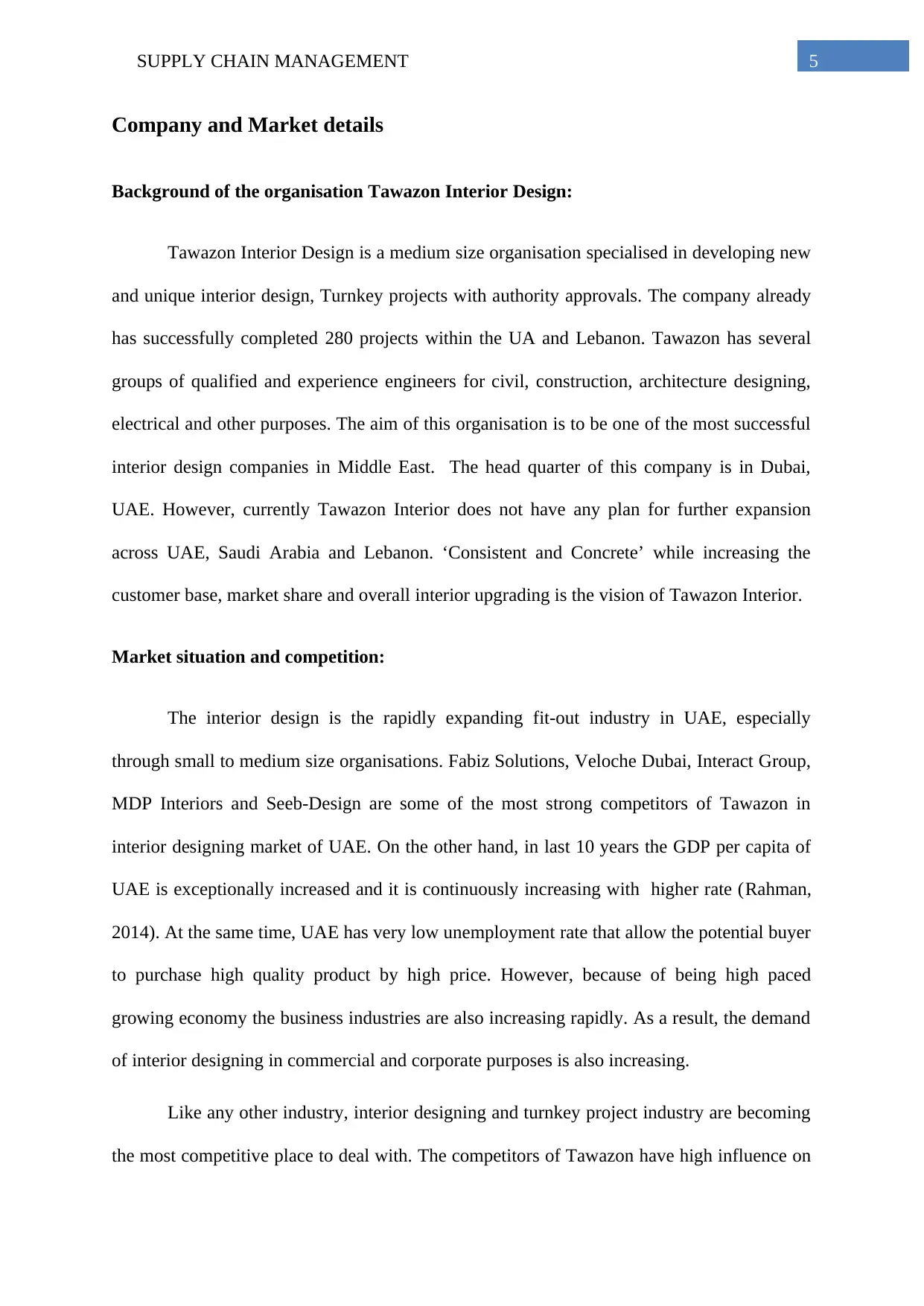
5SUPPLY CHAIN MANAGEMENT
Company and Market details
Background of the organisation Tawazon Interior Design:
Tawazon Interior Design is a medium size organisation specialised in developing new
and unique interior design, Turnkey projects with authority approvals. The company already
has successfully completed 280 projects within the UA and Lebanon. Tawazon has several
groups of qualified and experience engineers for civil, construction, architecture designing,
electrical and other purposes. The aim of this organisation is to be one of the most successful
interior design companies in Middle East. The head quarter of this company is in Dubai,
UAE. However, currently Tawazon Interior does not have any plan for further expansion
across UAE, Saudi Arabia and Lebanon. ‘Consistent and Concrete’ while increasing the
customer base, market share and overall interior upgrading is the vision of Tawazon Interior.
Market situation and competition:
The interior design is the rapidly expanding fit-out industry in UAE, especially
through small to medium size organisations. Fabiz Solutions, Veloche Dubai, Interact Group,
MDP Interiors and Seeb-Design are some of the most strong competitors of Tawazon in
interior designing market of UAE. On the other hand, in last 10 years the GDP per capita of
UAE is exceptionally increased and it is continuously increasing with higher rate (Rahman,
2014). At the same time, UAE has very low unemployment rate that allow the potential buyer
to purchase high quality product by high price. However, because of being high paced
growing economy the business industries are also increasing rapidly. As a result, the demand
of interior designing in commercial and corporate purposes is also increasing.
Like any other industry, interior designing and turnkey project industry are becoming
the most competitive place to deal with. The competitors of Tawazon have high influence on
Company and Market details
Background of the organisation Tawazon Interior Design:
Tawazon Interior Design is a medium size organisation specialised in developing new
and unique interior design, Turnkey projects with authority approvals. The company already
has successfully completed 280 projects within the UA and Lebanon. Tawazon has several
groups of qualified and experience engineers for civil, construction, architecture designing,
electrical and other purposes. The aim of this organisation is to be one of the most successful
interior design companies in Middle East. The head quarter of this company is in Dubai,
UAE. However, currently Tawazon Interior does not have any plan for further expansion
across UAE, Saudi Arabia and Lebanon. ‘Consistent and Concrete’ while increasing the
customer base, market share and overall interior upgrading is the vision of Tawazon Interior.
Market situation and competition:
The interior design is the rapidly expanding fit-out industry in UAE, especially
through small to medium size organisations. Fabiz Solutions, Veloche Dubai, Interact Group,
MDP Interiors and Seeb-Design are some of the most strong competitors of Tawazon in
interior designing market of UAE. On the other hand, in last 10 years the GDP per capita of
UAE is exceptionally increased and it is continuously increasing with higher rate (Rahman,
2014). At the same time, UAE has very low unemployment rate that allow the potential buyer
to purchase high quality product by high price. However, because of being high paced
growing economy the business industries are also increasing rapidly. As a result, the demand
of interior designing in commercial and corporate purposes is also increasing.
Like any other industry, interior designing and turnkey project industry are becoming
the most competitive place to deal with. The competitors of Tawazon have high influence on
⊘ This is a preview!⊘
Do you want full access?
Subscribe today to unlock all pages.

Trusted by 1+ million students worldwide
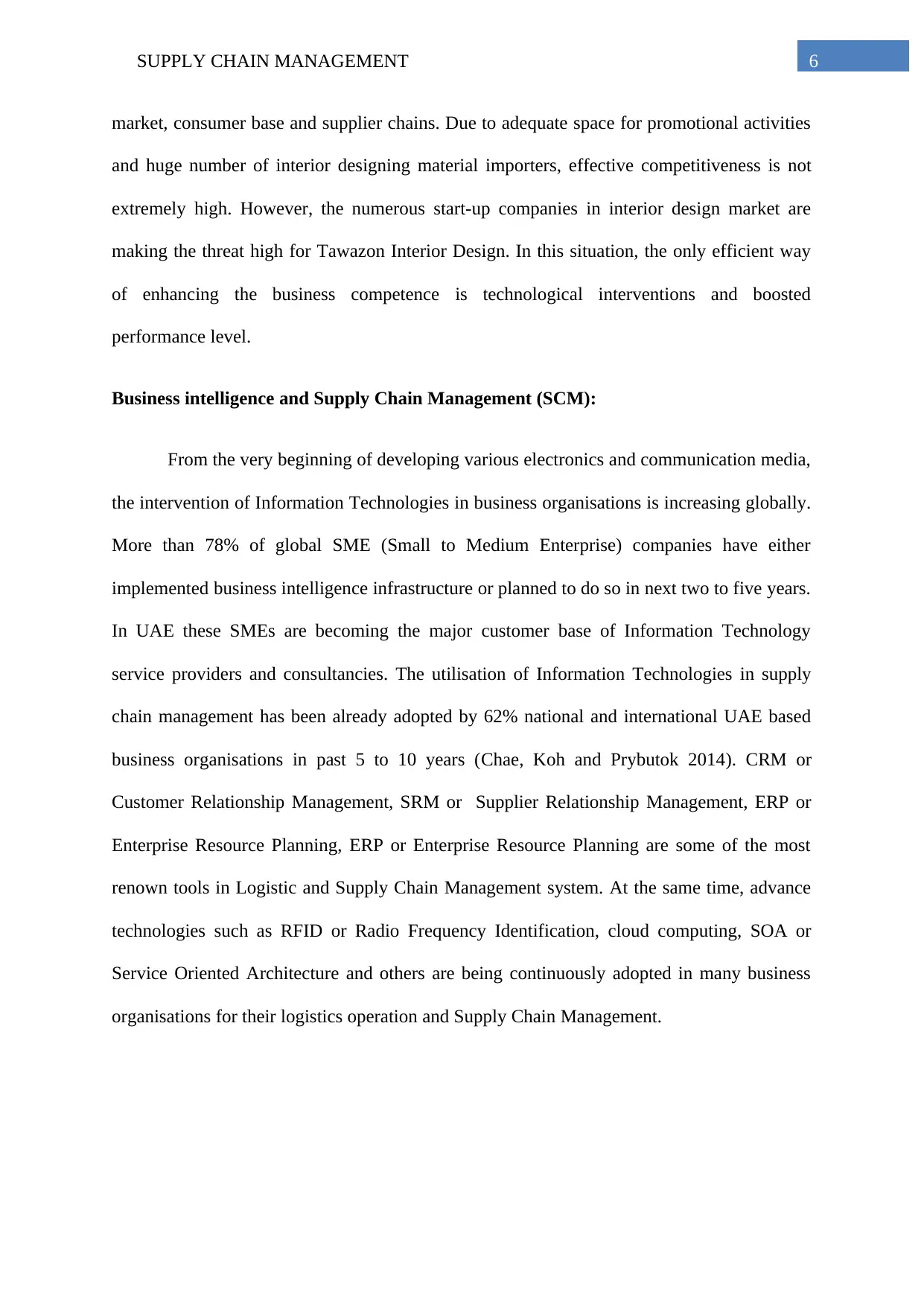
6SUPPLY CHAIN MANAGEMENT
market, consumer base and supplier chains. Due to adequate space for promotional activities
and huge number of interior designing material importers, effective competitiveness is not
extremely high. However, the numerous start-up companies in interior design market are
making the threat high for Tawazon Interior Design. In this situation, the only efficient way
of enhancing the business competence is technological interventions and boosted
performance level.
Business intelligence and Supply Chain Management (SCM):
From the very beginning of developing various electronics and communication media,
the intervention of Information Technologies in business organisations is increasing globally.
More than 78% of global SME (Small to Medium Enterprise) companies have either
implemented business intelligence infrastructure or planned to do so in next two to five years.
In UAE these SMEs are becoming the major customer base of Information Technology
service providers and consultancies. The utilisation of Information Technologies in supply
chain management has been already adopted by 62% national and international UAE based
business organisations in past 5 to 10 years (Chae, Koh and Prybutok 2014). CRM or
Customer Relationship Management, SRM or Supplier Relationship Management, ERP or
Enterprise Resource Planning, ERP or Enterprise Resource Planning are some of the most
renown tools in Logistic and Supply Chain Management system. At the same time, advance
technologies such as RFID or Radio Frequency Identification, cloud computing, SOA or
Service Oriented Architecture and others are being continuously adopted in many business
organisations for their logistics operation and Supply Chain Management.
market, consumer base and supplier chains. Due to adequate space for promotional activities
and huge number of interior designing material importers, effective competitiveness is not
extremely high. However, the numerous start-up companies in interior design market are
making the threat high for Tawazon Interior Design. In this situation, the only efficient way
of enhancing the business competence is technological interventions and boosted
performance level.
Business intelligence and Supply Chain Management (SCM):
From the very beginning of developing various electronics and communication media,
the intervention of Information Technologies in business organisations is increasing globally.
More than 78% of global SME (Small to Medium Enterprise) companies have either
implemented business intelligence infrastructure or planned to do so in next two to five years.
In UAE these SMEs are becoming the major customer base of Information Technology
service providers and consultancies. The utilisation of Information Technologies in supply
chain management has been already adopted by 62% national and international UAE based
business organisations in past 5 to 10 years (Chae, Koh and Prybutok 2014). CRM or
Customer Relationship Management, SRM or Supplier Relationship Management, ERP or
Enterprise Resource Planning, ERP or Enterprise Resource Planning are some of the most
renown tools in Logistic and Supply Chain Management system. At the same time, advance
technologies such as RFID or Radio Frequency Identification, cloud computing, SOA or
Service Oriented Architecture and others are being continuously adopted in many business
organisations for their logistics operation and Supply Chain Management.
Paraphrase This Document
Need a fresh take? Get an instant paraphrase of this document with our AI Paraphraser
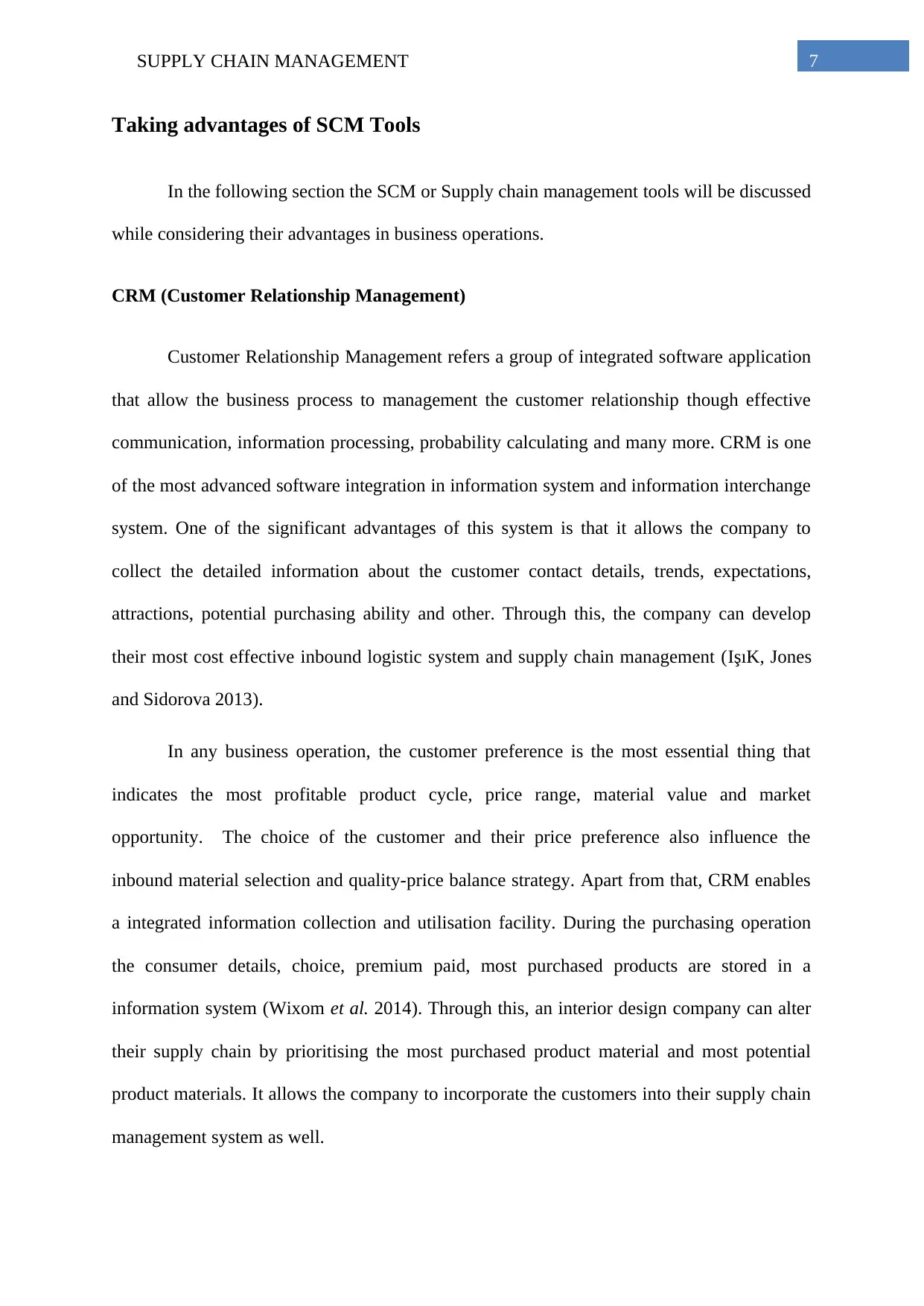
7SUPPLY CHAIN MANAGEMENT
Taking advantages of SCM Tools
In the following section the SCM or Supply chain management tools will be discussed
while considering their advantages in business operations.
CRM (Customer Relationship Management)
Customer Relationship Management refers a group of integrated software application
that allow the business process to management the customer relationship though effective
communication, information processing, probability calculating and many more. CRM is one
of the most advanced software integration in information system and information interchange
system. One of the significant advantages of this system is that it allows the company to
collect the detailed information about the customer contact details, trends, expectations,
attractions, potential purchasing ability and other. Through this, the company can develop
their most cost effective inbound logistic system and supply chain management (IşıK, Jones
and Sidorova 2013).
In any business operation, the customer preference is the most essential thing that
indicates the most profitable product cycle, price range, material value and market
opportunity. The choice of the customer and their price preference also influence the
inbound material selection and quality-price balance strategy. Apart from that, CRM enables
a integrated information collection and utilisation facility. During the purchasing operation
the consumer details, choice, premium paid, most purchased products are stored in a
information system (Wixom et al. 2014). Through this, an interior design company can alter
their supply chain by prioritising the most purchased product material and most potential
product materials. It allows the company to incorporate the customers into their supply chain
management system as well.
Taking advantages of SCM Tools
In the following section the SCM or Supply chain management tools will be discussed
while considering their advantages in business operations.
CRM (Customer Relationship Management)
Customer Relationship Management refers a group of integrated software application
that allow the business process to management the customer relationship though effective
communication, information processing, probability calculating and many more. CRM is one
of the most advanced software integration in information system and information interchange
system. One of the significant advantages of this system is that it allows the company to
collect the detailed information about the customer contact details, trends, expectations,
attractions, potential purchasing ability and other. Through this, the company can develop
their most cost effective inbound logistic system and supply chain management (IşıK, Jones
and Sidorova 2013).
In any business operation, the customer preference is the most essential thing that
indicates the most profitable product cycle, price range, material value and market
opportunity. The choice of the customer and their price preference also influence the
inbound material selection and quality-price balance strategy. Apart from that, CRM enables
a integrated information collection and utilisation facility. During the purchasing operation
the consumer details, choice, premium paid, most purchased products are stored in a
information system (Wixom et al. 2014). Through this, an interior design company can alter
their supply chain by prioritising the most purchased product material and most potential
product materials. It allows the company to incorporate the customers into their supply chain
management system as well.
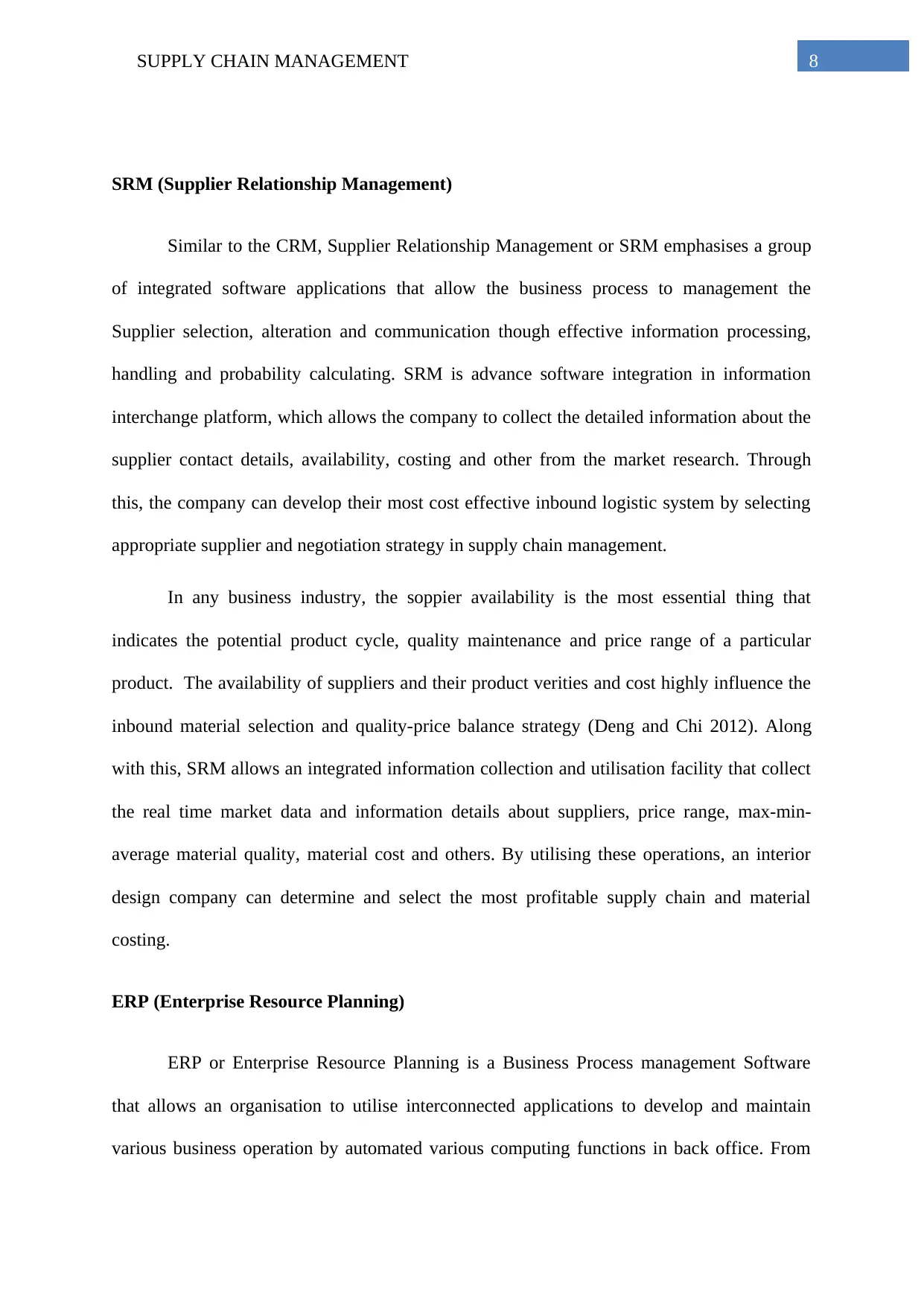
8SUPPLY CHAIN MANAGEMENT
SRM (Supplier Relationship Management)
Similar to the CRM, Supplier Relationship Management or SRM emphasises a group
of integrated software applications that allow the business process to management the
Supplier selection, alteration and communication though effective information processing,
handling and probability calculating. SRM is advance software integration in information
interchange platform, which allows the company to collect the detailed information about the
supplier contact details, availability, costing and other from the market research. Through
this, the company can develop their most cost effective inbound logistic system by selecting
appropriate supplier and negotiation strategy in supply chain management.
In any business industry, the soppier availability is the most essential thing that
indicates the potential product cycle, quality maintenance and price range of a particular
product. The availability of suppliers and their product verities and cost highly influence the
inbound material selection and quality-price balance strategy (Deng and Chi 2012). Along
with this, SRM allows an integrated information collection and utilisation facility that collect
the real time market data and information details about suppliers, price range, max-min-
average material quality, material cost and others. By utilising these operations, an interior
design company can determine and select the most profitable supply chain and material
costing.
ERP (Enterprise Resource Planning)
ERP or Enterprise Resource Planning is a Business Process management Software
that allows an organisation to utilise interconnected applications to develop and maintain
various business operation by automated various computing functions in back office. From
SRM (Supplier Relationship Management)
Similar to the CRM, Supplier Relationship Management or SRM emphasises a group
of integrated software applications that allow the business process to management the
Supplier selection, alteration and communication though effective information processing,
handling and probability calculating. SRM is advance software integration in information
interchange platform, which allows the company to collect the detailed information about the
supplier contact details, availability, costing and other from the market research. Through
this, the company can develop their most cost effective inbound logistic system by selecting
appropriate supplier and negotiation strategy in supply chain management.
In any business industry, the soppier availability is the most essential thing that
indicates the potential product cycle, quality maintenance and price range of a particular
product. The availability of suppliers and their product verities and cost highly influence the
inbound material selection and quality-price balance strategy (Deng and Chi 2012). Along
with this, SRM allows an integrated information collection and utilisation facility that collect
the real time market data and information details about suppliers, price range, max-min-
average material quality, material cost and others. By utilising these operations, an interior
design company can determine and select the most profitable supply chain and material
costing.
ERP (Enterprise Resource Planning)
ERP or Enterprise Resource Planning is a Business Process management Software
that allows an organisation to utilise interconnected applications to develop and maintain
various business operation by automated various computing functions in back office. From
⊘ This is a preview!⊘
Do you want full access?
Subscribe today to unlock all pages.

Trusted by 1+ million students worldwide
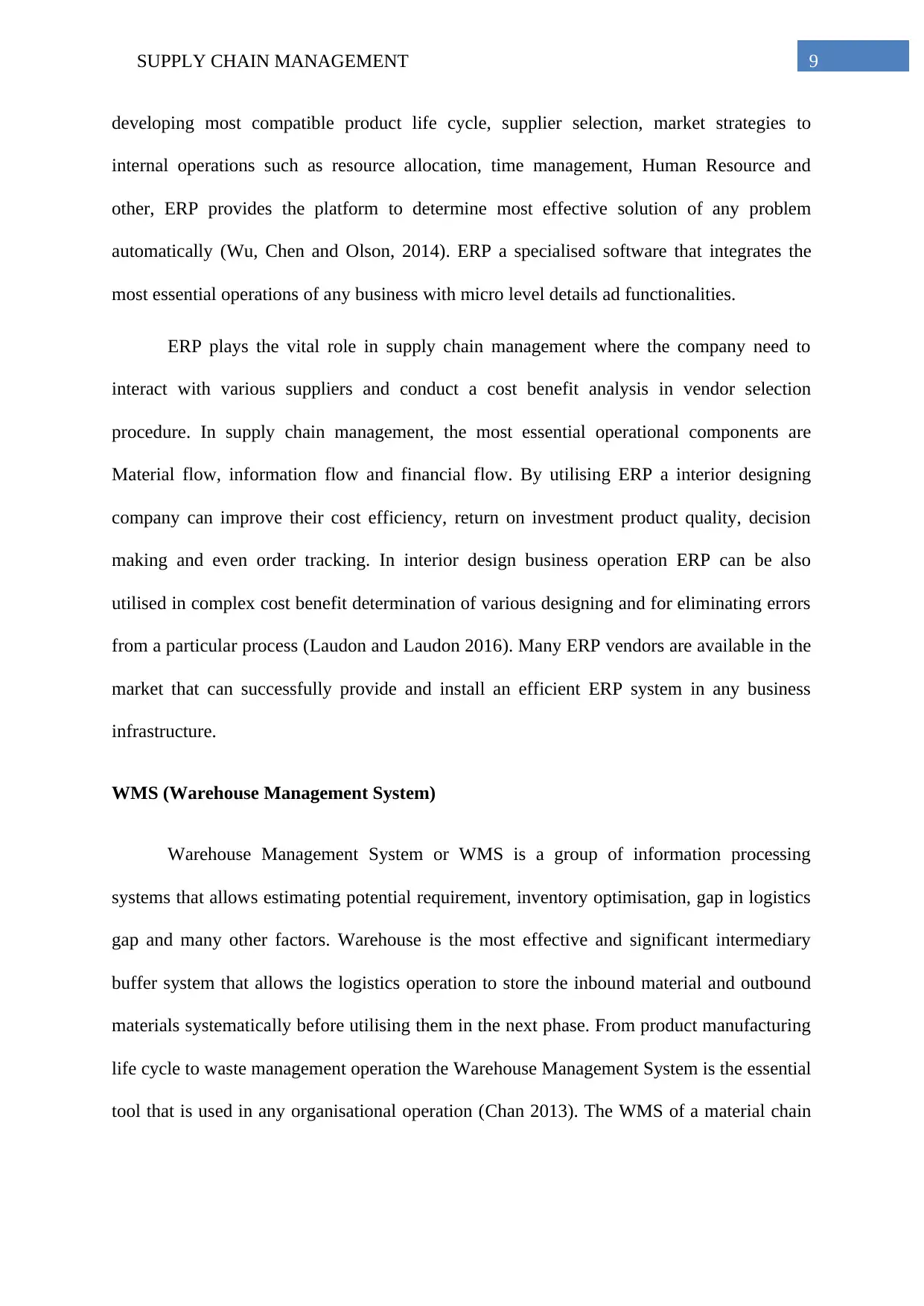
9SUPPLY CHAIN MANAGEMENT
developing most compatible product life cycle, supplier selection, market strategies to
internal operations such as resource allocation, time management, Human Resource and
other, ERP provides the platform to determine most effective solution of any problem
automatically (Wu, Chen and Olson, 2014). ERP a specialised software that integrates the
most essential operations of any business with micro level details ad functionalities.
ERP plays the vital role in supply chain management where the company need to
interact with various suppliers and conduct a cost benefit analysis in vendor selection
procedure. In supply chain management, the most essential operational components are
Material flow, information flow and financial flow. By utilising ERP a interior designing
company can improve their cost efficiency, return on investment product quality, decision
making and even order tracking. In interior design business operation ERP can be also
utilised in complex cost benefit determination of various designing and for eliminating errors
from a particular process (Laudon and Laudon 2016). Many ERP vendors are available in the
market that can successfully provide and install an efficient ERP system in any business
infrastructure.
WMS (Warehouse Management System)
Warehouse Management System or WMS is a group of information processing
systems that allows estimating potential requirement, inventory optimisation, gap in logistics
gap and many other factors. Warehouse is the most effective and significant intermediary
buffer system that allows the logistics operation to store the inbound material and outbound
materials systematically before utilising them in the next phase. From product manufacturing
life cycle to waste management operation the Warehouse Management System is the essential
tool that is used in any organisational operation (Chan 2013). The WMS of a material chain
developing most compatible product life cycle, supplier selection, market strategies to
internal operations such as resource allocation, time management, Human Resource and
other, ERP provides the platform to determine most effective solution of any problem
automatically (Wu, Chen and Olson, 2014). ERP a specialised software that integrates the
most essential operations of any business with micro level details ad functionalities.
ERP plays the vital role in supply chain management where the company need to
interact with various suppliers and conduct a cost benefit analysis in vendor selection
procedure. In supply chain management, the most essential operational components are
Material flow, information flow and financial flow. By utilising ERP a interior designing
company can improve their cost efficiency, return on investment product quality, decision
making and even order tracking. In interior design business operation ERP can be also
utilised in complex cost benefit determination of various designing and for eliminating errors
from a particular process (Laudon and Laudon 2016). Many ERP vendors are available in the
market that can successfully provide and install an efficient ERP system in any business
infrastructure.
WMS (Warehouse Management System)
Warehouse Management System or WMS is a group of information processing
systems that allows estimating potential requirement, inventory optimisation, gap in logistics
gap and many other factors. Warehouse is the most effective and significant intermediary
buffer system that allows the logistics operation to store the inbound material and outbound
materials systematically before utilising them in the next phase. From product manufacturing
life cycle to waste management operation the Warehouse Management System is the essential
tool that is used in any organisational operation (Chan 2013). The WMS of a material chain
Paraphrase This Document
Need a fresh take? Get an instant paraphrase of this document with our AI Paraphraser
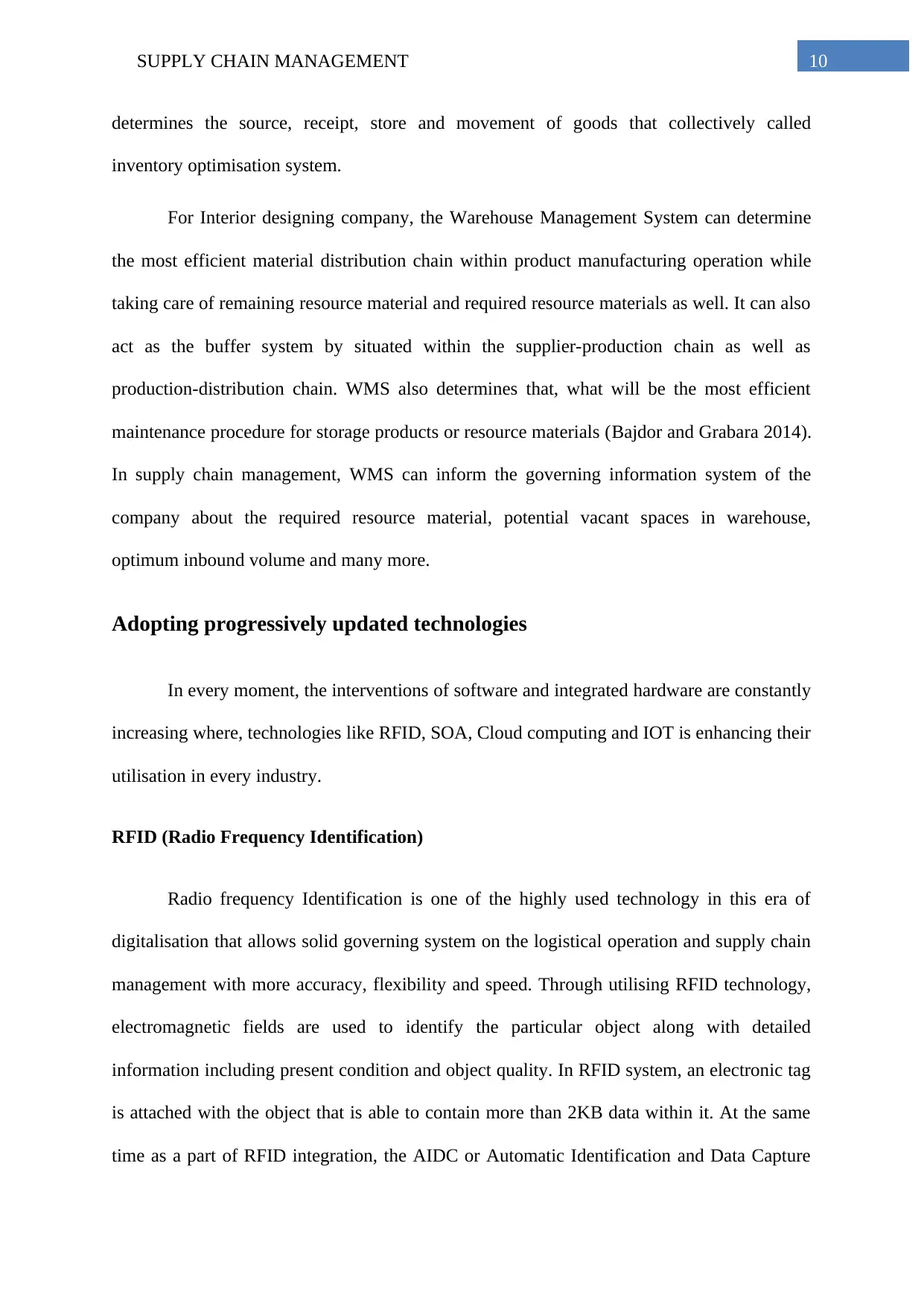
10SUPPLY CHAIN MANAGEMENT
determines the source, receipt, store and movement of goods that collectively called
inventory optimisation system.
For Interior designing company, the Warehouse Management System can determine
the most efficient material distribution chain within product manufacturing operation while
taking care of remaining resource material and required resource materials as well. It can also
act as the buffer system by situated within the supplier-production chain as well as
production-distribution chain. WMS also determines that, what will be the most efficient
maintenance procedure for storage products or resource materials (Bajdor and Grabara 2014).
In supply chain management, WMS can inform the governing information system of the
company about the required resource material, potential vacant spaces in warehouse,
optimum inbound volume and many more.
Adopting progressively updated technologies
In every moment, the interventions of software and integrated hardware are constantly
increasing where, technologies like RFID, SOA, Cloud computing and IOT is enhancing their
utilisation in every industry.
RFID (Radio Frequency Identification)
Radio frequency Identification is one of the highly used technology in this era of
digitalisation that allows solid governing system on the logistical operation and supply chain
management with more accuracy, flexibility and speed. Through utilising RFID technology,
electromagnetic fields are used to identify the particular object along with detailed
information including present condition and object quality. In RFID system, an electronic tag
is attached with the object that is able to contain more than 2KB data within it. At the same
time as a part of RFID integration, the AIDC or Automatic Identification and Data Capture
determines the source, receipt, store and movement of goods that collectively called
inventory optimisation system.
For Interior designing company, the Warehouse Management System can determine
the most efficient material distribution chain within product manufacturing operation while
taking care of remaining resource material and required resource materials as well. It can also
act as the buffer system by situated within the supplier-production chain as well as
production-distribution chain. WMS also determines that, what will be the most efficient
maintenance procedure for storage products or resource materials (Bajdor and Grabara 2014).
In supply chain management, WMS can inform the governing information system of the
company about the required resource material, potential vacant spaces in warehouse,
optimum inbound volume and many more.
Adopting progressively updated technologies
In every moment, the interventions of software and integrated hardware are constantly
increasing where, technologies like RFID, SOA, Cloud computing and IOT is enhancing their
utilisation in every industry.
RFID (Radio Frequency Identification)
Radio frequency Identification is one of the highly used technology in this era of
digitalisation that allows solid governing system on the logistical operation and supply chain
management with more accuracy, flexibility and speed. Through utilising RFID technology,
electromagnetic fields are used to identify the particular object along with detailed
information including present condition and object quality. In RFID system, an electronic tag
is attached with the object that is able to contain more than 2KB data within it. At the same
time as a part of RFID integration, the AIDC or Automatic Identification and Data Capture
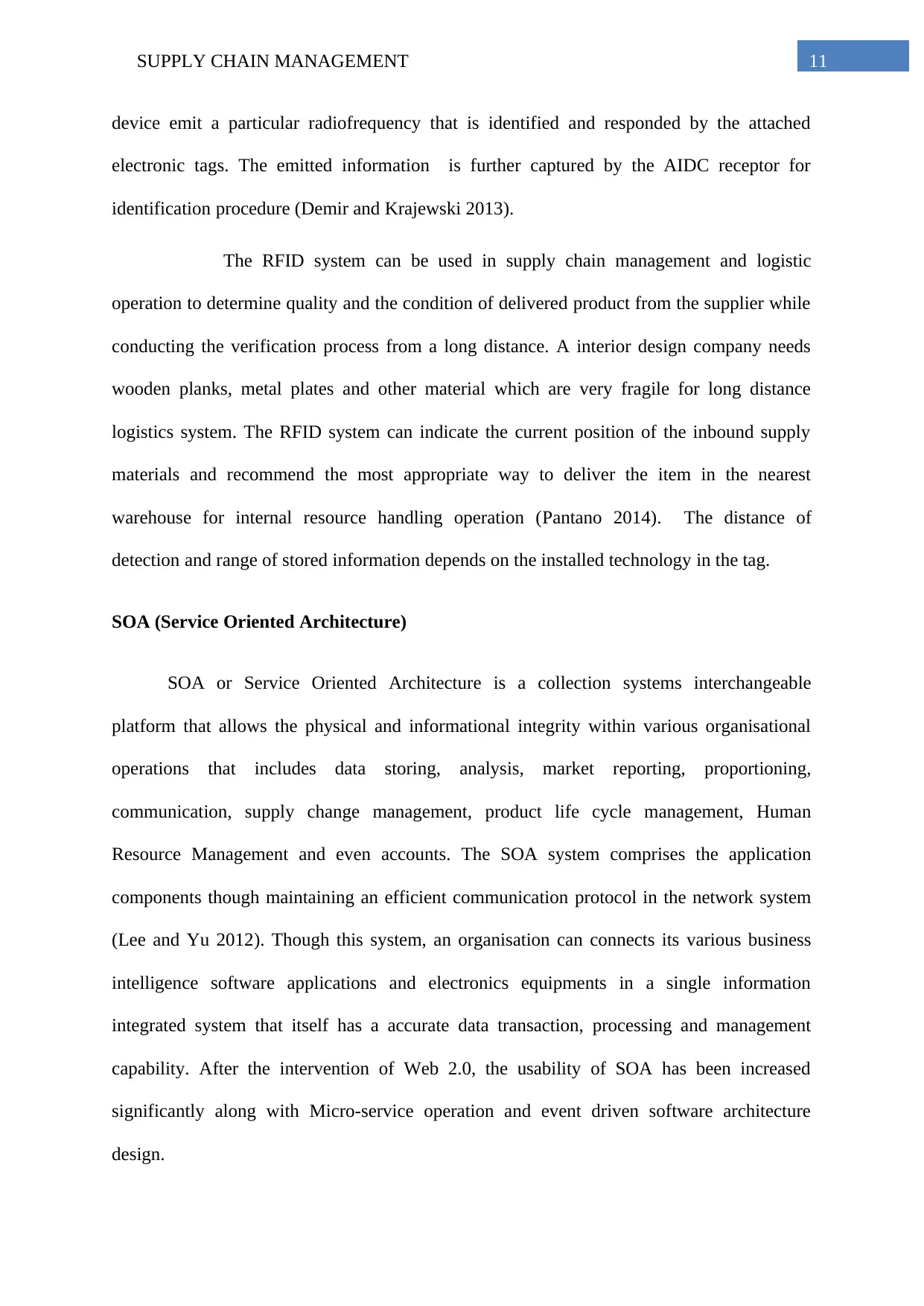
11SUPPLY CHAIN MANAGEMENT
device emit a particular radiofrequency that is identified and responded by the attached
electronic tags. The emitted information is further captured by the AIDC receptor for
identification procedure (Demir and Krajewski 2013).
The RFID system can be used in supply chain management and logistic
operation to determine quality and the condition of delivered product from the supplier while
conducting the verification process from a long distance. A interior design company needs
wooden planks, metal plates and other material which are very fragile for long distance
logistics system. The RFID system can indicate the current position of the inbound supply
materials and recommend the most appropriate way to deliver the item in the nearest
warehouse for internal resource handling operation (Pantano 2014). The distance of
detection and range of stored information depends on the installed technology in the tag.
SOA (Service Oriented Architecture)
SOA or Service Oriented Architecture is a collection systems interchangeable
platform that allows the physical and informational integrity within various organisational
operations that includes data storing, analysis, market reporting, proportioning,
communication, supply change management, product life cycle management, Human
Resource Management and even accounts. The SOA system comprises the application
components though maintaining an efficient communication protocol in the network system
(Lee and Yu 2012). Though this system, an organisation can connects its various business
intelligence software applications and electronics equipments in a single information
integrated system that itself has a accurate data transaction, processing and management
capability. After the intervention of Web 2.0, the usability of SOA has been increased
significantly along with Micro-service operation and event driven software architecture
design.
device emit a particular radiofrequency that is identified and responded by the attached
electronic tags. The emitted information is further captured by the AIDC receptor for
identification procedure (Demir and Krajewski 2013).
The RFID system can be used in supply chain management and logistic
operation to determine quality and the condition of delivered product from the supplier while
conducting the verification process from a long distance. A interior design company needs
wooden planks, metal plates and other material which are very fragile for long distance
logistics system. The RFID system can indicate the current position of the inbound supply
materials and recommend the most appropriate way to deliver the item in the nearest
warehouse for internal resource handling operation (Pantano 2014). The distance of
detection and range of stored information depends on the installed technology in the tag.
SOA (Service Oriented Architecture)
SOA or Service Oriented Architecture is a collection systems interchangeable
platform that allows the physical and informational integrity within various organisational
operations that includes data storing, analysis, market reporting, proportioning,
communication, supply change management, product life cycle management, Human
Resource Management and even accounts. The SOA system comprises the application
components though maintaining an efficient communication protocol in the network system
(Lee and Yu 2012). Though this system, an organisation can connects its various business
intelligence software applications and electronics equipments in a single information
integrated system that itself has a accurate data transaction, processing and management
capability. After the intervention of Web 2.0, the usability of SOA has been increased
significantly along with Micro-service operation and event driven software architecture
design.
⊘ This is a preview!⊘
Do you want full access?
Subscribe today to unlock all pages.

Trusted by 1+ million students worldwide
1 out of 28
Related Documents
Your All-in-One AI-Powered Toolkit for Academic Success.
+13062052269
info@desklib.com
Available 24*7 on WhatsApp / Email
![[object Object]](/_next/static/media/star-bottom.7253800d.svg)
Unlock your academic potential
Copyright © 2020–2025 A2Z Services. All Rights Reserved. Developed and managed by ZUCOL.




